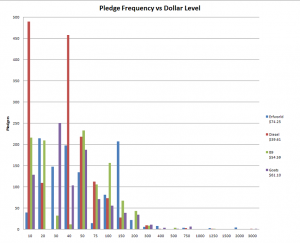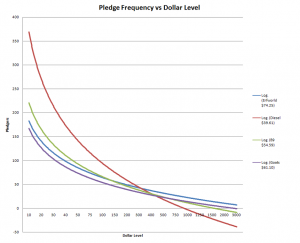Apparently, I Had Nothing Better To Do
I watched Jon Rosenberg’s Kickstarter campaign close just north of US$55,000 and in all-time the sixth highest slot for comics projects¹, and I started wondering if there were anything in common among these high-value webcomic Kickstarts. Waaaay too much number-crunching later, I find there actually is something among the most successful. Caveats ahoy:
- The sample size is small, being drawn from the most successful and concluded comics Kickstart campaigns
- I’ve excluded the Womanthology as it’s not the product of singly-identifiable creators, working from an established property
- I’ve excluded the Order of the Stick campaign for several reasons:
- The numbers are skewed by the high number of reward categories
- The numbers within those categories are skewed by highly-variable reward limits (some limits in the range of 100, some in the range of five or six)
- The numbers are even further skewed by a high incidence of “add on” rewards, where a supporter could get something not offered at their reward by bumping up their pledge by a given amount
- I wanted to compare against campaigns that were just shy of successful for comparison, but it’s really damn hard to find those; a fairly exhaustive search of failed webcomics campaigns causes me to tend towards the conclusion If you’re gonna fail, you’re gonna fail big
- To simplify things, I arranged reward levels in broad ranges, since there are no “standard” reward intervals; where you see the number “20” in the graphs, that means “greater than the 10 level to the immediate left, up to and including 20”
All that being said, I did find a fairly interesting commonality among the projects that I ultimately did data entry on:
- Erfworld Year of the Dwagon — US$84,981 pledged, 1148 supporters, average pledge level US$74.25, 354% of goal achieved
- Diesel Sweeties eBook-Stravaganza 3000 — US$60,209 pledged, 1520 supporters, average pledge level US$39.61, 2006% of goal achieved
- Benign Kingdom — US$59,775, 1095 supporters, average pledge level US$54.59, 332% of goal achieved
- Goats Book IV: Inhuman Resources — US$55,348, 906 supporters, average pledge level US$61.10, 461% of goal achieved
Looking purely at the stated support levels (and there’s no adjustment here for artificial limits on how many of a particular reward were offered, nor for people pledging at an amount “between” official reward levels, there’s not a lot of obvious correlation to be seen:
With some really significant outliers there from Diesel Sweeties. But the curves of each comic’s pledge frequency seemed to be similar (at least, if you’ve spent a bunch of years looking at data), which led me to add some logarithmic trendlines²:
Three of those comics have trendlines that are similar enough to arguably be within the bounds of the margin of error (if not for the fact that the very notion of a margin of error on such a small sample is ludicrous). There’s a real tendency towards buy-in the lower half of the reward structure, and the second quartile is where the real action is. The top rewards look impressive when a couple people plunk down a couple grand each, but they aren’t what’s important. The middle tiers are where you’ll find the make or break point.
The Diesel Sweeties curve is again an outlier, starting higher and decaying more sharply. I didn’t feel like cleaning them up, but random samples of failed Kickstarts from across the comics category revealed a similar pattern — when the greatest number of pledges are at the lowest levels, it’s really tough to make your goals. The only other successful Kickstart I found with a dominant skew to the very lowest end was the Double Fine door-buster, where more than 50% of all backers are at the lowest possible level³. So how do Double Fine and Diesel Sweeties get by on front-loading the low end, and why do so many other campaigns that do the same fail? I see two reasons:
- Sheer numbers The scale really cannot be overstated here. A cursory examination of the top-funded project in each major category revealed that you can take the total number of pledgers for all of those projects together and still not equal the 47,946 people that pledged at the lowest level to Double Fine. But numbers can work against a campaign, since any reward more more tangbile than warm fuzzy feelings will cost a significant amount of time and effort to send to a lot of people, on small margins. That leads us to …
- Free rewards You get the new Double Fine game, which requires no shipping, no handling, and it’s likely Steam will supply the bandwidth. Likewise, the lowest reward for the Diesel Sweeties campaign is a digital download that doesn’t cost Rich Stevens even one trip to the post office. Yeah, sure, bandwidth costs. Peanuts compared the effort and cost of getting anything physical to 490 people.
So that’s what I learned — there’s a sweet spot for rewards in about the US$25 – US$75 range, and unless you’re dealing with a metric crapload of supporters with an essentially free cost to fulfill rewards, don’t try for success on the low end. Also, these numbers are severely lacking in rigor, so if you make your Kickstarter decisions based solely on what I’ve done here without your own research, you’ll get exactly what you deserve, you silly people
_______________
¹ Although that notion is itself a bit nebulous; for example, the Schlock Mercenary boardgame campaign is in a different category, yet clearly owes its mammoth success (third overall in the category, as of this writing) to the underlying webcomic. Then again, the Not Invented Here IT barrier tape campaign (in the Product Design category) doesn’t rely on the webcomic’s familiarity to nearly the same degree. Your mileage will vary.
² Ask Zach Weiner; he’ll do a better job of explaining it than I will.
³ By contrast, Diesel Sweeties had approximately 1/3 of its support at the lowest level that allowed for an actual reward. Erfworld and Benign Kingdom were closer to 1 in 5, and Goats was in the range of 1 in 8. Note that “actual reward” here is taken to be “at least a PDF of the work in question”. Random thanks, postcards, bragging rights, etc., are not considered an actual reward.


Excellent analysis! This kind of data is really the kind of thing that will help the community as a whole have a better understanding of how to get their own projects off the ground.
By johnny vu on 03.24.12 6:02 pm
Nice! I’ve been reading a lot about successful Kickstarter campaigns lately and this is some interesting info.
There are a lot of failed campaigns out there and ‘front-loading’ the rewards structure is an intriguing problem. Thanks!
By Paul on 03.27.12 10:29 am
[…] those who like to think about numbers, Gary Tyrrell has looked at the four top-grossing Kickstarter comics drives, and while the sample size is admittedly small, he has come up with some interesting correlations. […]
By Goats is back — by popular demand | Robot 6 @ Comic Book Resources – Covering Comic Book News and Entertainment on 03.30.12 3:01 pm
[…] leaving a mere 59.5 days to top things up. I’m going to be very interested at seeing what the graph of their contributions looks like once June arrives, but I suspect it’s not going to look anything like those that I […]
By Fleen: Home Of The Webcomics Action News Team! » Of Course He Registered It on 04.02.12 3:12 pm
[…] desire for a cool videogame that features Dr McNinja doing awesome things, but rather because the rewards hypothesis I’m working on identifies low-dollar-value pledge rewards as a particular […]
By Fleen: Home Of The Webcomics Action News Team! » A Quote You May Enjoy on 04.11.12 3:05 pm
[…] tried laying out some of my (very early) analysis and desire for a Grand Unified Theory of Kickstarter, but so far my attention has been on the numbers and not the words to describe it. I should have […]
By Fleen: Home Of The Webcomics Action News Team! » MoCCA 2012, Part Four on 05.03.12 3:48 pm
The above comments are owned by whoever posted them. The staff of Fleen are not responsible for them in any way.